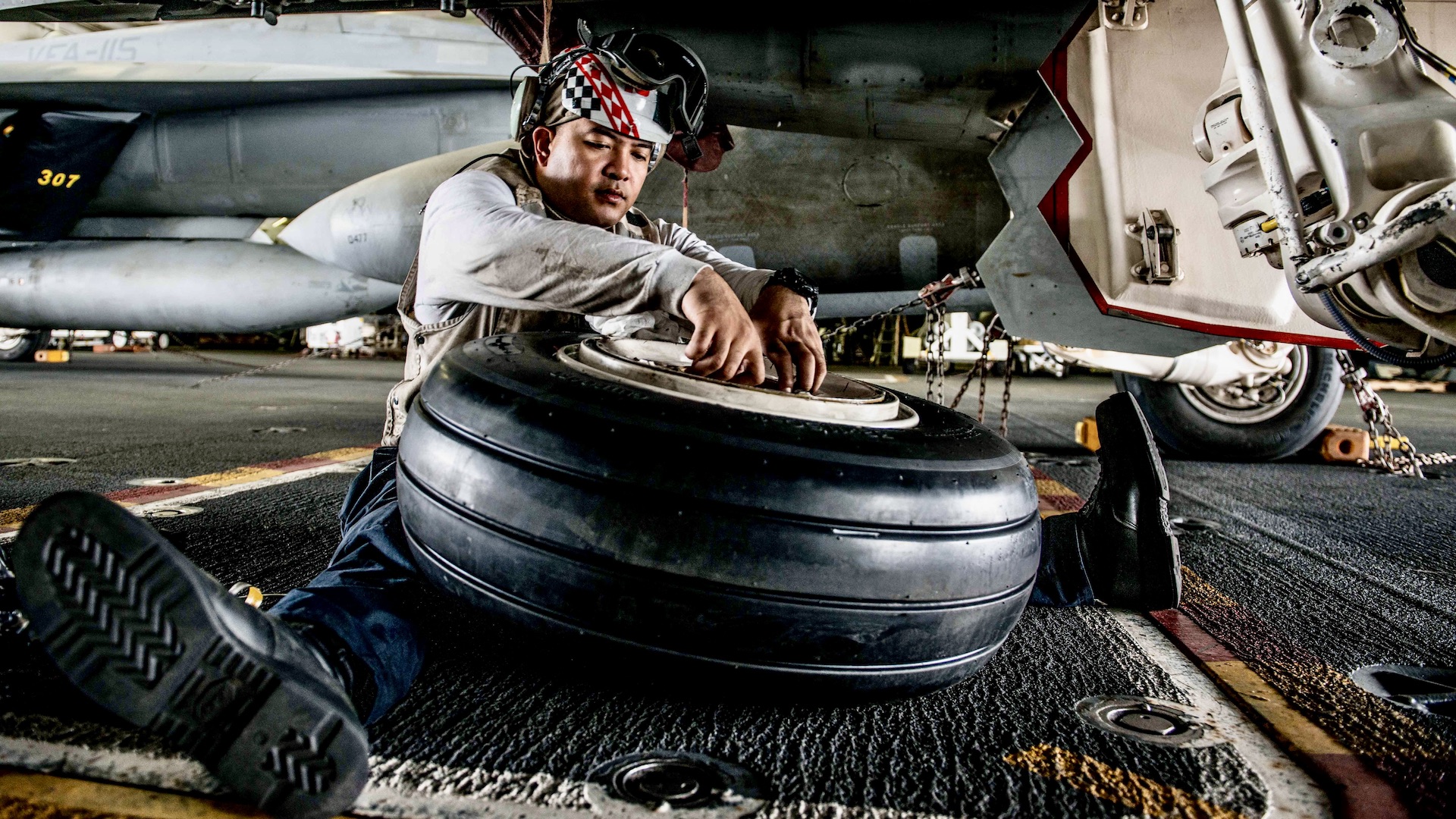At the recent Sea Air Space conference near Washington D.C., Theodore Gronda, program manager for Naval Air Systems Command’s (NAVAIR) Additive Manufacturing (AM) Team told an audience that replacement tires for the F/A-18E/F Super Hornet are wildly expensive.
How much? According to Gronda, replacing them costs nearly six figures each. That’s partly because they are swapped out along with the wheels they’re mounted on. The Navy actually buys replacement Super Hornet tires as assemblies, receiving tires/wheel rims already mated to each other. Each tire/wheel assembly costs approximately $100,000.
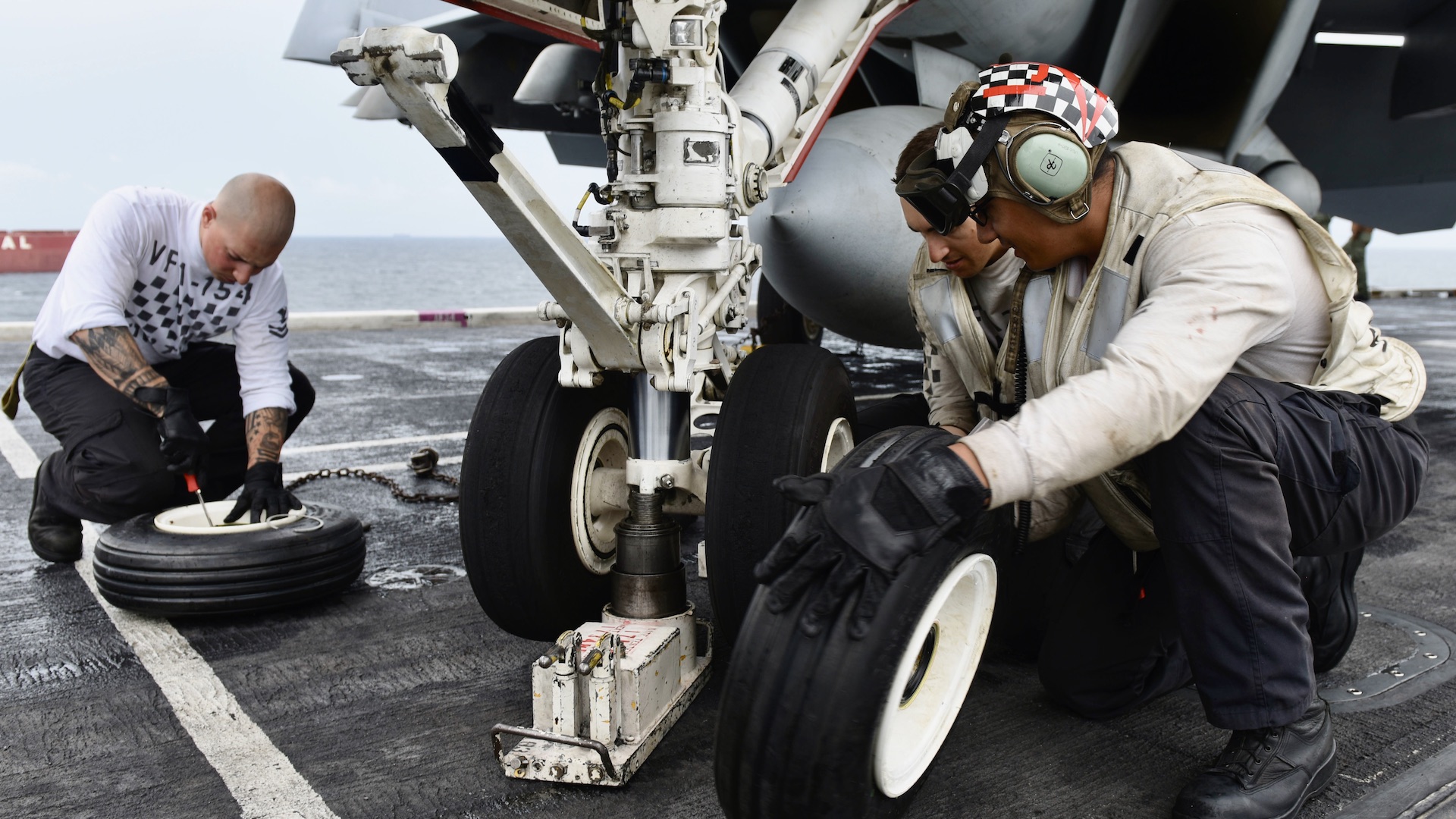
There’s no doubt that wheels and tires on a carrier aircraft like the Super Hornet lead hard, relatively short lives. Since 2019, the Navy’s E/F fleet has progressively undergone a multi-phase service life modification program which stretches the fighter’s service life from 6,000 to 10,000 hours. Over that service life Super Hornets make literally thousands of landings and takeoffs, both arrested landings and catapult takeoffs from aircraft carriers and takeoffs and landings from fixed bases. In the process they consume many wheels and tires, using them up particularly quickly during carrier operations.
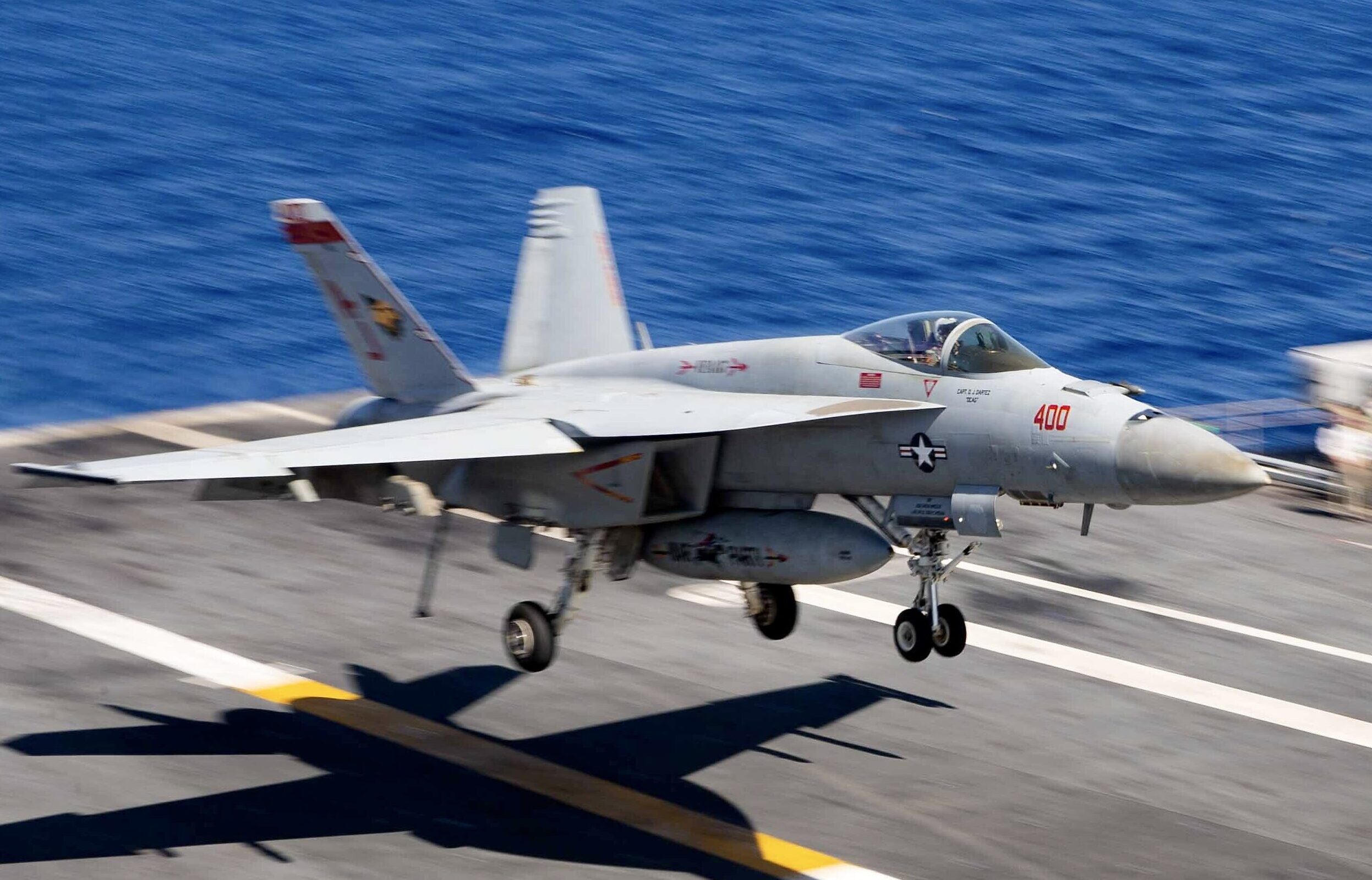
Gronda explained that F/A-18E/F pilots often land hard on carrier decks, causing the fighter’s main landing gear wheel rims to oblong and the tire mounted on the rim to shake. If the tire wobbles, he said, the wheel and tire assembly is taken off and discarded.
That gets expensive very quickly. “We go through 166 of these tires a year and they cost six figures apiece,” Gronda affirmed to the Sea Air Space audience. According to Boeing, Goodyear and Michelin supply rubber for the Rhino. The War Zone reached out to each company asking for their tire price for the F/A-18/E/F. Both declined to share it. The main landing gear wheels are supplied by Honeywell Aerospace, Aircraft Landing Systems which likewise declined to provide price information.
Assuming a nominal $100,000 per-assembly price, simple math shows that the Navy’s Super Hornet wheel assembly replacement bill for aircraft with out-of-round rims amounts to somewhere around $16.6 million per year.

If the rims could be fixed and the tires remounted, the Navy’s wheel/tire bill might go down significantly. Gronda explained that NAVAIR’s AM team recognized a possible opportunity to repair Super Hornet rims using solid-state cold spray 3D printing technology.
“There wasn’t an effective way to repair [them]… We realized that eighty percent of those rims are repairable with cold spray technology.”
Cold spray is an additive manufacturing process that tweaks standard 3D printing. In simple terms, tiny metal particles are mixed with a carrier gas (typically nitrogen or helium) and accelerated to Mach 2-3 speeds through a nozzle. For cold spray repairs, the particles are sprayed directly onto a part, adding material to build it back up and strengthen it.
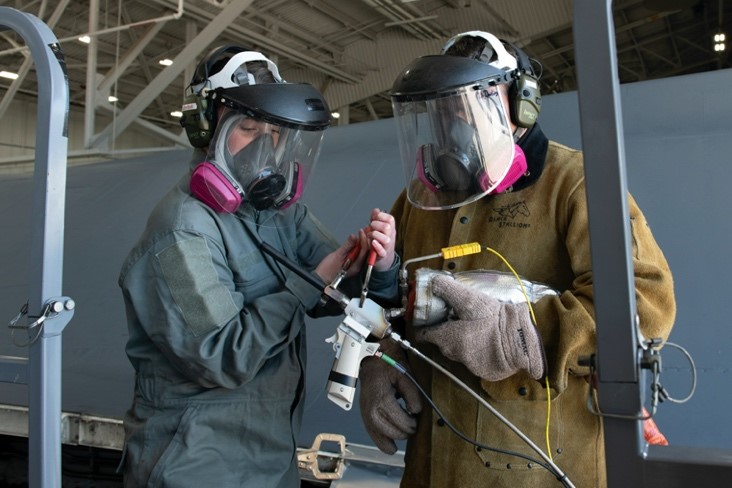
“Cold spray” is a bit of a misnomer. The additive particles used are heated but only to less than 80% of their melting point, rendering them fungible. The particles coalesce into a solid state, creating a high-strength, structurally sound bond. Once applied, the new material is modified to match the original shape or tolerances of the part being repaired. In that way, solid-state cold spray is both an additive and subtractive process.

The Air Force has been using the cold spray process with additive manufacturing machines since 2020, repairing rather than replacing everything from aircraft hinges to structural supports, shafts, and landing gear components. The service used solid-state cold spray to repair an over-wing fairing slip joint for a B-1B in 2021. It’s possible that the process may be used to aid in regenerating a decommissioned Lancer recently pulled from storage as The War Zone reported.
NAVAIR began adopting additive manufacturing technology over a decade ago and employed it to build its first flight critical aircraft component — a 3D printed link and fitting assembly for a V-22 Osprey engine nacelle — in 2016. Supply chain issues driven by the COVID-19 pandemic forced the Navy to accelerate its investment in, and use of, additive manufacturing beginning in 2020. Today, NAVAIR has furnished 96 additive manufacturing devices to 33 sites, including deployed aircraft carriers.
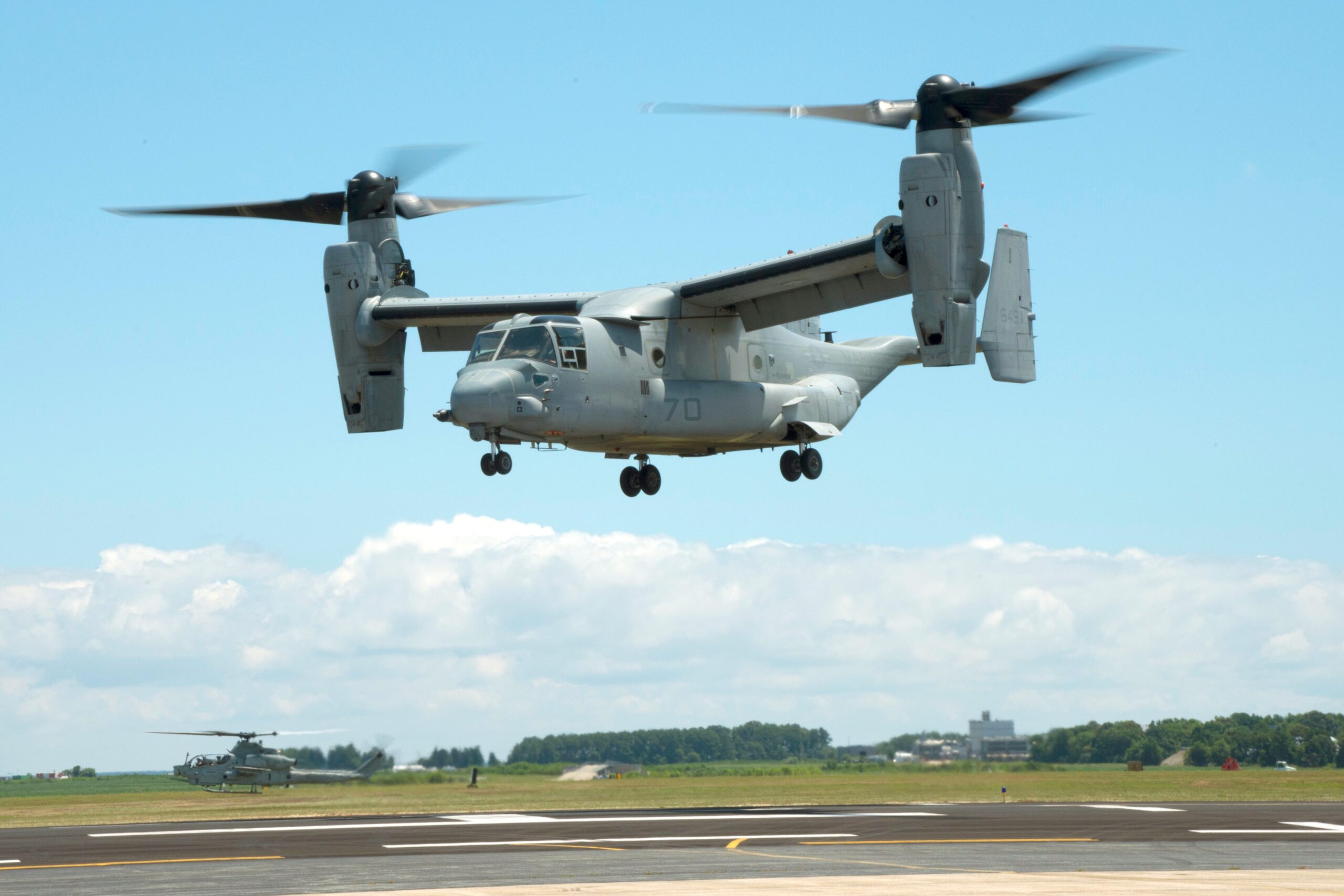
The Command uses a variety of 3D printers to make repairs to flight critical components. In 2021 NAVAIR awarded a five-year IDIQ contract worth up to $5 million to deliver fully-deployable 3D printing systems including Ultimaker S5 3D printers.
That investment looks set to pay off across different platforms and equipment types including Super Hornet tire/wheel assemblies. In an email response to questions from The War Zone, Gronda reaffirmed that the AM team’s “initial assessment is that over 80% of the 166 [wheel rims/tires] sent to [scrapping/recycling] each year are repairable with this cold spray technique.”
He added that the cold spray repairs to each take two hours and cost $300 per wheel. That works out to a total cost of about $40,000 to repair the rims and re-mount the tires annually. Set against a $16.6 million bill to simply replace the assemblies as customary, AM repair looks like a no-brainer. Its potential to be employed in the field and/or in forward operating locations, like an aircraft carrier, adds further value.
For example, the AM team recently facilitated the speedy provision of new coupler fittings for a deployed aircraft carrier’s optical landing system. Thanks to fatigued couplers, the system had failed, preventing some of the aircraft aboard from flying. Once contacted, the team redesigned the small fitting for 3D printing, tested it, received approval, and sent the coupler data electronically to the ship where it was then printed.
That said, Navy fighter squadrons will not be making Super Hornet rim repairs at sea. According to Gronda, the environmental requirements that come with the metal powders used during the cold spray process mean that such repairs can only be done at shore-based installations and maintenance facilities at the present.

But the broader repair-rather-than-replace idea that goes hand in hand with additive manufacturing is inspiring NAVAIR and the Navy as a whole to reconsider its supply chain design and deployment, Gronda explained.
“Cold spray is causing us to reevaluate items already in the supply system. These items were previously deemed not repairable/consumable, so reevaluating this process could help us reduce overall sustainment costs, harvest those savings and reinvest in more critical DoD capabilities.”
In February, NAVAIR and Naval Sea Systems Command (NAVSEA) opened the Naval Aviation Schoolhouse for Additive Manufacturing in Danville, Virginia. With a team of instructors on hand, six-week courses held at the schoolhouse will produce a pipeline of AM artisans to meet growing supply and re-supply needs at lower cost and on shorter timelines.
The supply chain pressures that the Pentagon is under, from munitions to parts to equipment, combined with budget pressures and inefficiencies (right down to paying $90,000 for a simple bag of washers) will hopefully drive more innovative approaches to fixing or locally manufacturing hardware instead of simply firing the parts cannon at problems. A $16-plus million annual wheel/tire bill for a single fighter type, which could be reduced to less than $50,000, is the kind of opportunity that the services can’t afford to squander.
Contact the editor: tyler@twz.com
